Two Websites, Two Dramatically Different Results
April 10th, 2025.
In October 2023 I decided to try out the avalanche SEO strategy, employing the approach on MemberSherpa.com to to see how it would work to grow our search traffic in a highly competitive niche.
Internet marketing is a crowded space, so the keyword profile in this niche is ‘difficult’ to say the least. Still, I thought that we could produce some very solid growth for our site using the avalanche strategy — much better growth than many other established sites.
The reality turned out to be very different, as you’ll see below. But, before you get discouraged, I I’m going to show you the results from a second website that produced far better results after I made some tweaks to the approach.
Avalanche SEO Strategy
The Avalanche SEO strategy’s aim is to progressively lift the ranking “power” or “authority” of a website. This is basically a measure of what terms Google will trust your site for without any SEO.
Google will rank articles without much in the way of SEO effort or links based on how much authority a site has. This authority is derived from the amount of traffic already coming in to the site from articles that the site admin has not implemented SEO tactics or links to boost. As a site publishes these sort of articles and gains traffic, it is able to rank for progressively higher volume keywords as the site gains more traffic without the use of anything but the most basic SEO.
What type of keywords can you rank for without really any SEO effort?
Easy keywords.
These keywords tend to have ultra low volume as indicated by popular keyword tools, and have a very low keyword golden ratio (KGR). The keyword golden ratio is a ratio of the number of articles directly targeting a search term divided by the estimated monthly search volume.
Aside from including the keyword in the title, H1, and URL, we’re only using the keyword in the body of the article at least once. We’re not doing anything else in terms of on page SEO. No keyword density, no optimizing for secondary keywords or alternative terms, no optimized images, no focus on including the right article sections, bullet points, alt tags, etc… just the title, H1, URL, and a keyword in the body at least once. This is extremely lazy SEO.
We didn’t do any extensive link building for ranking purposes, either. Instead, we just linked internally between these ultra easy avalanche articles and a hub page or other target page.
We did, however, be link from our social accounts back to our website and be submittde our business information on various directories. I did not expect social or directory links to provide page rank because Google looks at these as EAT signals rather than links that should pass page rank. This EAT effort is all basic stuff that any business will want to do to help satisfy Google’s EAT requirements. We also provided some links from 3 of our other owned properties to MemberSherpa.com to help Google find and start indexing the site. We didn’t do link building aside from this, though, and these links — I correctly thought had minimal impact on our SEO.
We did – I should point out – create basic non-optimized pages for important terms that we wanted to use as hub or target pages that have very high volume but that are also very competitive to rank for. I didn’t not expect to get much or any traffic from these pages, though. We’re a new site and have no authority so it’s not realistic to think that we could rank for these pages. We created them because they are important to have for our readers and because we want to cover the membership site niche thoroughly.
Why go the Avalanche route?
This strategy supposedly provides ROBUST website traffic without having to worry about Google updates as we are not boosting the site via links or highly tailored SEO content. Google updates should have actually benefited us. It is also supposedly extremely effective in elbowing our way into a very competitive niche for search. I assumed that we’d face much less competition using this strategy since almost everyone just goes after the tough high volume keywords. Lastly, growing our website tier would help us more easily rank for tougher keywords further down the line.
To Sum: We wrote on very easy no volume keywords and gradually ramped up the volume of the keywords we wrote on. We didn’t do much / any SEO aside from having the keyword in the Google title, H1, URL, and the body of the article, and we didn’t build any links to help us rank.
Goals and Projections
While this was case study, not an experiment, it made sense to have some goals to work towards. So, here’s what I thought we can do over 12 months:
- Goal: I set the goal of 40 average daily unique search visitors by the end of the 12 month period
- Projection: I thought it would take us about 2 to 3 months to start seeing our content indexed on Google due to Google’s issues indexing new sites
- Projection: I thought we would see very small traffic growth over the first 6 months. This was expected as we were writing initially on very low volume keywords
- Projection: We would see the largest increases in absolute search traffic towards the end of the 12 month period as we progressively move to larger volume Avalanche keywords
Our ability to hit that 40 number really came down to how soon Google found and indexed our website, and the number of easy higher volume Avalanche keywords we could find. If Google did not index us for 3 months, it would put us 3 months behind; and obviously we could gain much more search traffic if we write on higher volume keywords.
Remember, internet marketing is a tough niche in which to rank. Most sites build their SEO traffic using boost, such as backlinks and other off page / on page tactics. This approach allows sites to rank for keywords that would otherwise be outside of their natural tier. The problem with this is that Google can take that boost away when it sees fit, resulting in very erratic traffic and a lot of work trying to put out fires to maintain your traffic.
By building a site using the avalanche strategy, there’s no boost to take away, so traffic continues fairly smoothly, without you having to put out fires to try to regain rankings. As one competitor falls out of the top search rankings, your site is left and can take their spot.
We start writing September 15th, 2023. It should be fun to watch!
Month 1: Avalanche SEO Case Study Start
October 15th, 2023
We started the case study with a productive month, publishing a number of articles and other pages:
- 22 Avalanche support pages
- 1 Target page
- 2 Category pages
- 1 Tools page
- 7 Administrative pages
- 4 Writer pages, and one team page
- 3 Case studies
Our aim at the start was to publish 30 support articles per month. We fell short, but still published 41 pages.
I picked support pages for ranking ease and estimated volume. We write on keywords in our tier, as assessed by estimated volume.
Our sole target page wasn’t not ranking, as expected, since it is a high volume keyword with moderate difficulty and we are a new site.
Search traffic was anemic to start, again as expected but impressions have really stepped up and we started to see a few visits. We sat just under 9 impressions per day on average for the last week of the month.
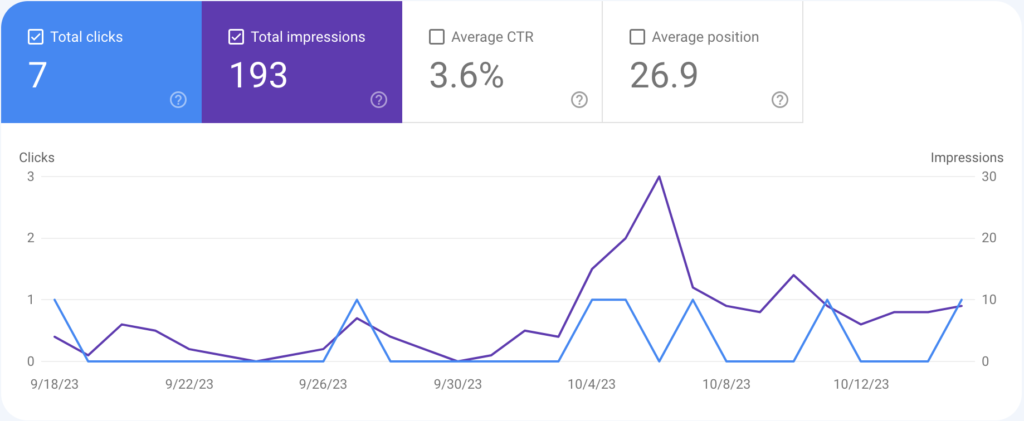
Avalanche Tiers…
Fresh sites need to start on Avalanche Tier Zero, targeting keywords that are reported on keyword tools to have no traffic. The original strategy had sites moving up to the next tier, Avalanche Tier 10, as their organic search traffic stepped up to 10 visits per day.
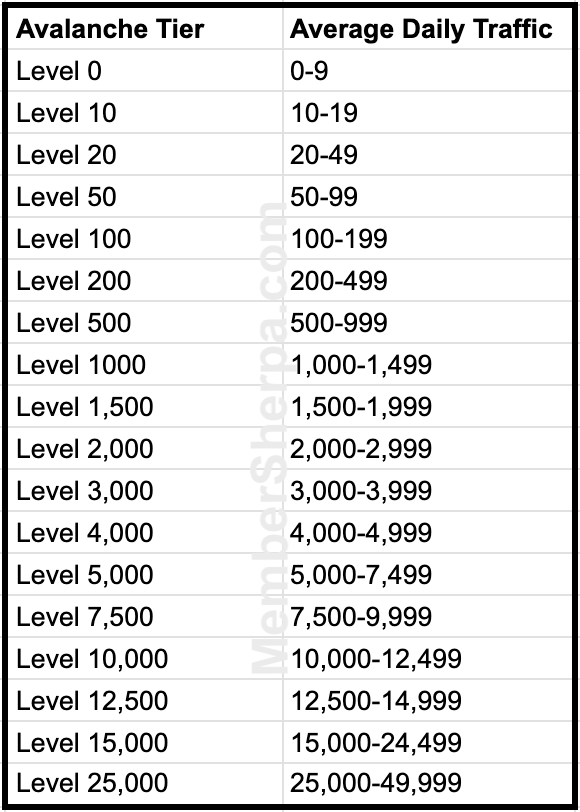
There is an alternative assessment, though, for smaller volume tiers. Rather than assessing your tier based on visits, you can also use average daily impressions.
During the first month we decided to move up to the second tier, Avalanche Tier 10, since we were sitting just under 10 impressions per day on average and had 7 no volume keyword articles completed and waiting to publish. The articles we wrote would have also taken time to rise in the Google SERP, and we would see more impressions and clicks from them over the next two months. If we waited, we’d rise in average daily volume accordingly, and that would allow us to rank for Avalanche keywords that have slightly higher volume.
My thinking was that we might as well write Avalanche Tier 10 keywords because we were virtually guaranteed to be in that next higher tier in a week or two based on the articles we already wrote. Our Avalanche Tier 10 articles would then start to rank pretty easily.
Important note: All this talk of writing articles for zero volume keywords and hoping to move up to articles with an average monthly volume of 10 seems pretty silly. But, you have to remember that the word “Avalanche” in this strategy’s name implies compound growth, so traffic should get very large over the course of a year or two. It’s like rolling a snowball down a hill. Near the bottom of the hill the snowball should be a towering giant, but we had to start with a tiny bit of snow.
Month 6th: Avalanche Traffic Lifts Off
Half way through the case study we saw a noticeable uptick in traffic. Yes, traffic was still small, but the total number of visitors increased significantly on a percentage basis and kept growing rapidly.
We kept writing 20 to 30 support articles each month for the first half of the case study For month 6, our progress was:
- 25 pages published total for the month, consisting of…
- 24 support articles
- 1 case study
Consistently publishing articles since late September 2023 has lead to this trend in visits:
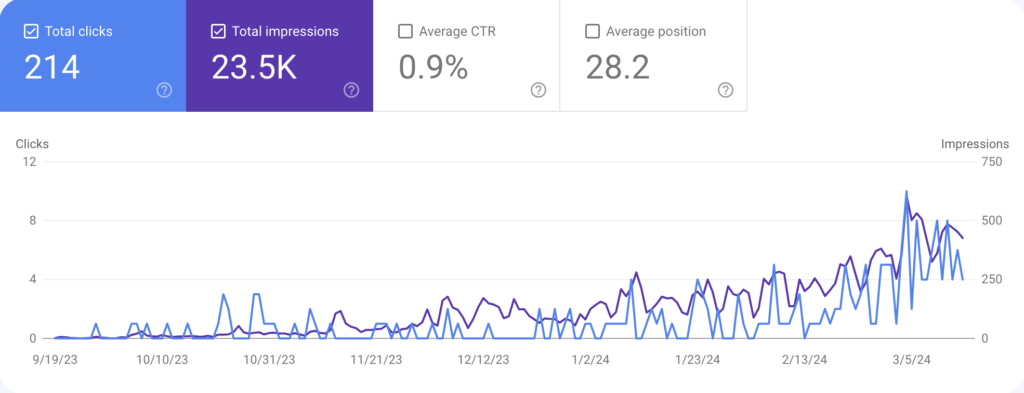
For the first half of March 2024, we’ve averaged 5.33 visits per day. This compares to:
September 15-30th 2023 (Case study start): 0.12 visits per day
December 1st-15th 2023: 0.33 visits per day
January 1st-15th 2024: 1 visit per day
February 1st-15th 2024: 1.27 visits per day
Interestingly, our compound monthly rate of growth is very large:
From December: 152% monthly CAGR
From January: 131% monthly CAGR
From February: 320% monthly CAGR
I thought this might have said something about our trajectory, but our approach was still the tortoise vs the hare. A 320% growth rate was a way too high for the rest of the year, so I considered this an outlier. But, I did think we should be able to maintain a good growth rate for the 12 month period and hit that 40 figure mentioned in the opening post.
In month 2 we also decided to move from Kleq to WordPress. We were using Kleq software, which we found great, but decided to move the site and all contents due to limitations with adding schema, and questions about how Google would treat sites with <p> tags wrapped in <div> tags.
When you are competing in a tough niche, such as internet marketing, small limitations will really hold you back. So, despite being otherwise happy with Kleq, we moved.
Month 11: Avalanche SEO Case Study Nearly Finished
We saw some decent gains by month 11, mostly coming in on the final day of the month.
First, the writing progress. Writing was a bit more variable month to month in the second half of the year. For month 11, we wrote 18 avalanche articles, 2 less than hoped each month.
Traffic hit 29 visitors per day on August 15th, up from 18 clicks on July 15th, and from the July peak of 21. That represents a 61% increase from July 15th, and 38% from our July peak.
Our average visits came in at 16.25 for the month. This is considerably behind peak traffic.
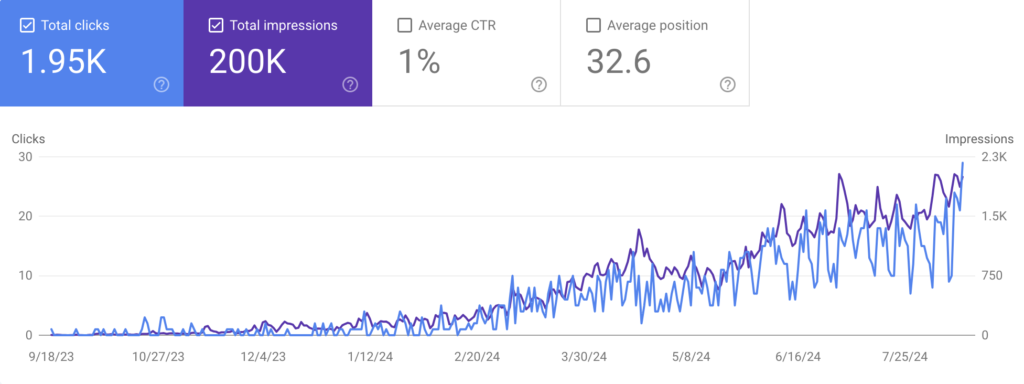
You’ll notice that the one month growth in visits (11) is a figure that first took us a full 6 months to achieve after we started. By the end of the case study it only took us 1 month to grow that amount… and my thoughts were that the speed of increase would continue — compound growth in action.
You’ll also notice that our growth also came in steps. It seems that after a short period of stagnation, traffic picked up to some new level. This can’t be explained by bulk article uploads, since we uploaded throughout the month fairly regularly.
My explanation is that Google pauses for a period of time before allowing our site to go ahead and rank for more keywords or move up in the SERPs. This could be a sort of sandboxing at various traffic tiers. Not sure.
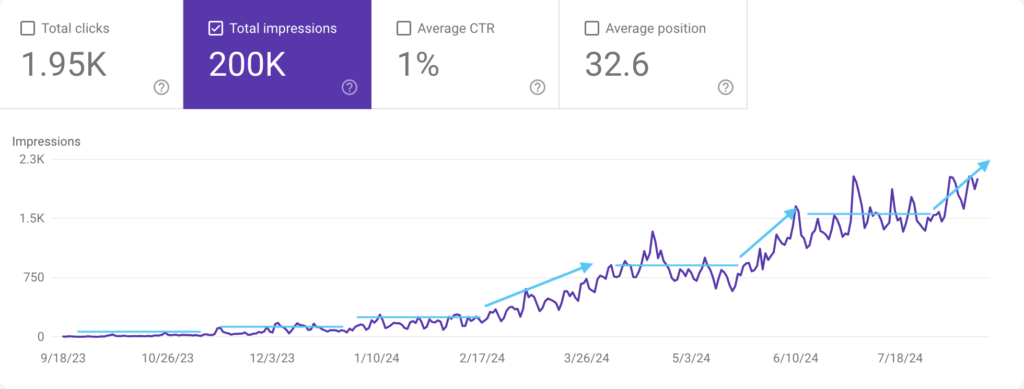
You can see the steps up in traffic in the chart above. It’s easier to see this trend with views rather than visits since visits are more volatile.
It seemed by month 12 that we were on another upward increase in traffic, and would average about 30 per day at the end of our case study. This was a month or so behind our traffic goal of 40 average visits at the end of our 12 month period.
Month 12: Avalanche SEO Case Study Disaster
Grave news to report.
Just as we were sprinting to the finish line, Google decided to extend its foot and trip up our progress. Big G rolled out an update in mid-August which caused our impressions to be cut in half and traffic to drop significantly.
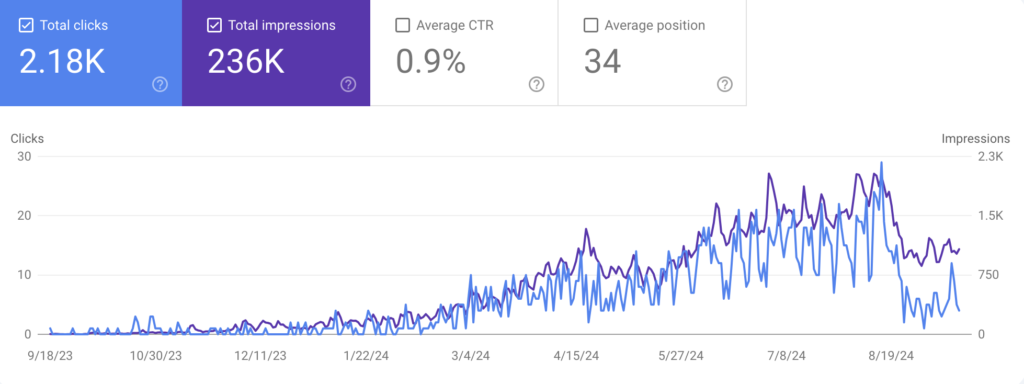
On August 12th, we hit a peak of 2030 impressions, which was followed a couple of days later by our max clicks at 29. From there, our impressions tumbled to 865, and clicks dropped to just 1. Yikes!
I wasn’t worries at first, but as time rolled on it was clear that something had gone badly wrong. We just were not regaining our rankings. My initial plan was to keep publishing support articles over the next 12 months, along with target page articles. Instead, I sought an outside expert opinion…
Avalanche Case Study Post Mortem
I turned to a friend, Ernesto at Structural SEO, to diagnose what had gone wrong. Ernesto is a data-focused SEO who applies the scientific process to understanding Google’s algorithm.
Ernesto gave three reasons for why my site was hit:
- Too many no-volume keywords. Google was penalizing websites that had a lot of pages that received zero traffic. We wrote a lot of terms that showed zero search traffic, as some SEOs suggest, and those terms were delivering for us — with no search traffic.
- Not enough link building. The Avalanche SEO technique is not a complete system, and Google still needs links to rank sites. Getting links natively did not work. Combining too many zero traffic pages with no links hit the site.
- Incomplete EEAT. We had not completely finished our EEAT work. While it was extensive, lacking a few items in this YMYL niche could have played a role.
To address these, we unpublished a lot of pages that received zero traffic, and hired some citation building service to build out links for us. The result was a rebound in traffic, though not back to pre-crisis levels.
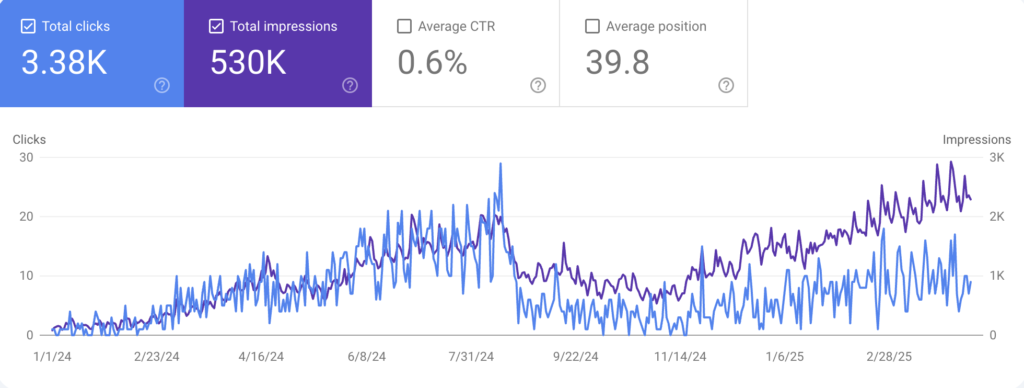
Future work will focus more on link building and writing higher traffic articles.
In terms of our Projections…
Projection #1 – 40 hits per day. We undershot by about 25%, and would have hit 40 a month later if Google had not hit our site.
Projection #2 – 2 to 3 month to index articles. Indexing happened much quicker than expected, actually by the end of month one.
Projection #3 – Very small traffic growth over the first 6 months. This was indeed the case.
Projection #4 – Largest traffic increase towards the end. This is indeed what happened. We saw the largest traffic gains as we moved to higher volume keywords. This was pretty obvious to forecast.
Second Avalanche SEO Attempt
Near the end of the Member Sherpa case study, I started a second website, Event Driven Daily, and applied the same SEO strategy. But, after Member Sherpa’s implosion and my consultation with Ernesto, I applied a few tweaks to the Avalanche SEO technique:
- I hired a citation building service right away.
- I published press releases to build links after a lot of citations were build.
- I unpublished a lot of zero volume keywords.
- I made sure that all of our EEAT was completed ASAP.
The results have been extraordinarily different. Where Member Sherpa saw slower growth and a sudden fall off, Event Driven Daily has been a strong performer, ramping up traffic significantly over a 12 month period.
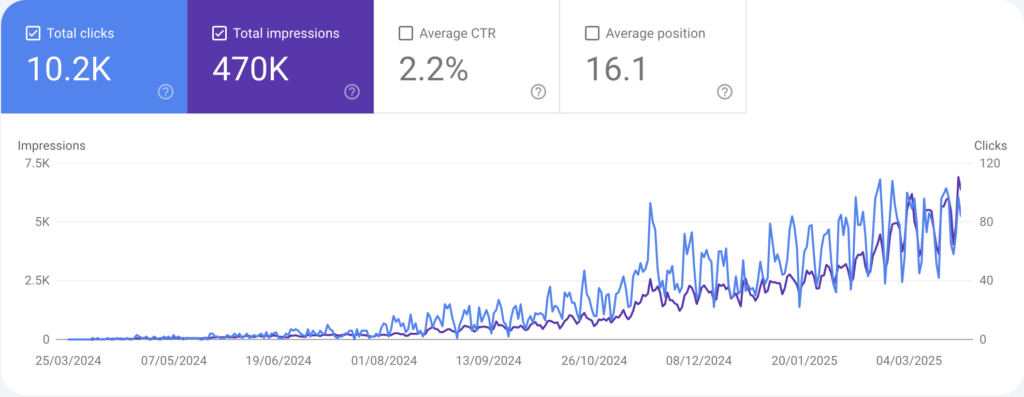
We ended the period with just under 90 clicks per day. Event Driven Daily has grown faster then Member Sherpa, and growth in impressions has been very steady.
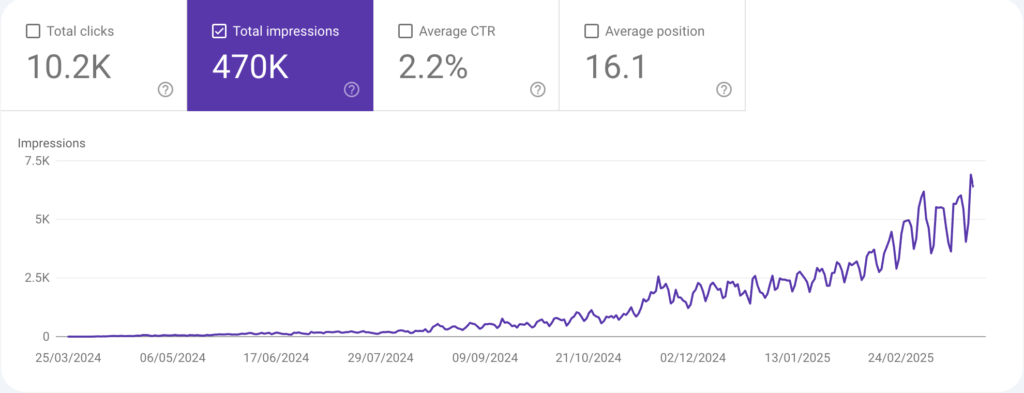
Traffic continues to climb to date, but we’re nearly at the end of the avalanche terms we’ve found, so will have to focus on tougher keywords going forward.
All-in-all, our Avalanche SEO Technique should be good for around 150 average daily clicks, and we’ll have to begin competing harder after that.

Lessons Learned – What I Would Do If I Started The Avalanche SEO Technique Case Study Today
This has been a very interesting case study (for me at least). I’ve learned a lot, and have come to a few conclusions. If I were starting this case study today, I would…
- Move as rapidly out of the bottom couple of Avalanche Tiers as possible. Basically, I would use Tier Zero and Tier 10 only for the first month, and publish maybe 20-30 articles total.
- Use impressions rather than clicks to estimate my tiers. Basically, impressions seems to work better than clicks when it comes to estimating your tiers, and would help me move up the Avalanche ladder faster.
- Hire a service to build citations as I write. I would start maybe at Tier 10, and build out 100 to 200 citations.
- Do a couple of press releases to build links after building citations.
With these 4 changes, I would expect the site to do pretty well using the strategy. Not including these seems to have tripped up Member Sherpa.
Since Event Driven Daily is doing so well (and getting customers) I have shifted my attention to that site. When I do resume my work on member Sherpa, though, I plan on doing more link building and writing articles on higher tiers. That should go a long way to boosting the site’s traffic.

